

 |
Wisconsin Bioscope Laboratory |  |
| Chemical Development |
|
| Like our competitors from the
1910s, the Wisconsin Bioscope Company prides itself on doing all its
own laboratory work, from developing the original negative to
assembling the final projection print. For Plan B,
its first production, the film was developed on an 100 foot metal reel,
much like the one pictured in the advertisement on the right for the
Stineman System.
Despite several successful practices with dummy film, the reel proved
very difficult to load. Other problems arose during development, which
consisted of dunking the reel in a two gallon tank of successive
chemicals. Once the film was developed and washed, it had to be
unreeled and dried. This, too, was surprising for its difficulty.
However, in the end, the laboratory work for Plan B was a success, a painful, seven-hours-in-the-dark, technically
flawed success that the firm does not wish to repeat. |
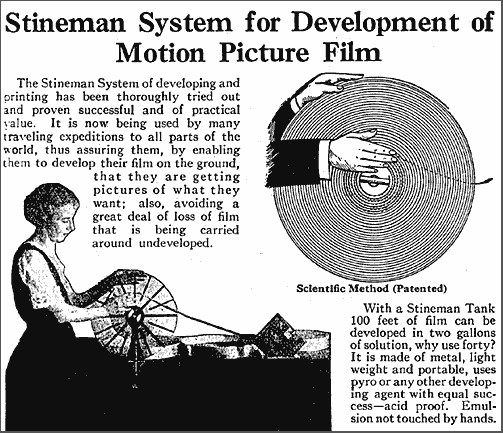 |
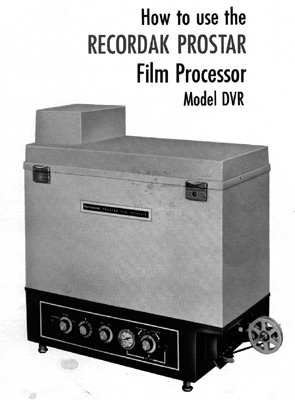 |
Since then, Wisconsin Bioscope has acquired a
small automatic
processor designed for developing microfilm. The Recordak Prostar is a
tabletop
machine distributed by George Eastman’s Kodak Company. It runs at a set
rate of five feet a minute with a
temperature range of about 80° to 110° F., so that 100 feet of
film is developed, washed, and dried in 20 minutes. Its tanks
hold a third of a gallon of each chemical. By using different
developers and temperatures, the Prostar can adequately develop both
the camera negative and the projection positive. We have also used it
to
tint and tone film. (An illustration from the operations manual is at
left.) Unfortunately, this machine does not dry the film completely by itself. An additional drying stage was constructed (the white tower illustrated on the right), so that now the work of developing the film is no more difficult than roasting a wild boar in a pit of coals. |
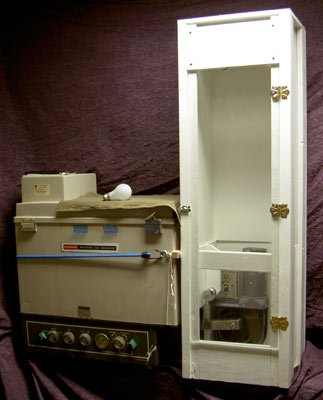 |
| Film Printing |
||
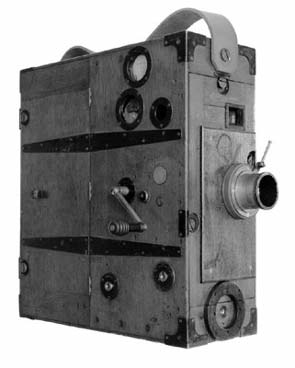 |
Like development, printing has been a struggle at times for the Wisconsin Bioscope. For Winner Take All,
our second production, we used the Bioscope camera itself as a printer.
This produced a sharp print but the process was difficult and slow. Then the company obtained a Stineman Motion Picture Printer, a small machine once marketed to the amateur and scientific market. It was patented in 1916. We motorized it and added film magazines for supply and take-up. The motorized Stineman continuous printer works quickly but produces inconsistent results. However, most of the time the prints are mostly sharp, so the company is mostly content until a better machine is found. |
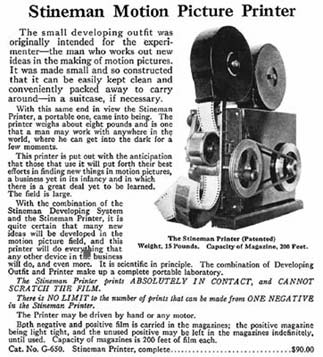 |
| The Bioscope camera which was used as a printer by sending two films through at the same time and replacing the lens with an electric light. |
An advertisement for the Stineman Printer from a Burke and James catalog. |
|
| Have you a better printing machine gathering dust in your laboratory? Why not donate it to the Wisconsin Bioscope Company today! |
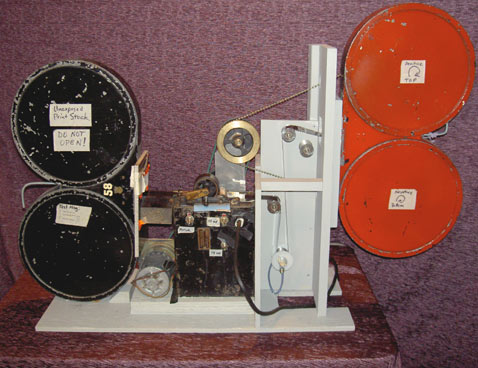 |
| Wisconsin Bioscope’s motorized continuous printer. The Stineman printer is the black box in the center. |

|
 |